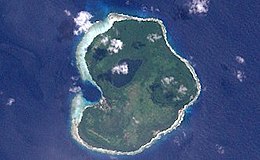Owaraha
 Landsatpicture of the island. | |
 Owaraha (Santa Ana) is located off the eastern end of Makira Island | |
| Geography | |
|---|---|
| Location | South Pacific Ocean |
| Coordinates | 10°49′42″S162°27′49″E/ 10.82833°S 162.46361°E |
| Archipelago | Solomon Islands (archipelago) |
| Area | 15.7 km2(6.1 sq mi) |
| Highest elevation | 143 m (469 ft) |
| Highest point | Farina |
| Administration | |
| Province | Makira-Ulawa Province |
| Demographics | |
| Population | 1547 (2009) |
OwarahaorOwa Raha(also known asSanta Ana) is an island inMakira-Ulawa Province,Solomon Islands.
Description[edit]
This relatively smallcoralisland is 5.6 km long and 4.5 km wide. It is located at the eastern end ofMakira(San Cristobal), separated from it by a 7.5 km wide strait, and just north of smallerOwariki(Santa Catalina). The sound between Owaraha and Owariki is only 2.5 km wide. The island has two main villages Gupuna (or Ghupuna) and Nafinotoga. The inhabitants of Owaraha speak theOwa languageand share the same culture with the people in Owariki and in the eastern end of Makira Island. The Pagewa and Aiga Tatari clans of Owaraha and other nearby islands claim descent from the refugees fromTeonimanuwhich was washed away.
History[edit]
First recorded sighting by Europeans was by the Spanish expedition ofÁlvaro de Mendañaon 4 July 1568. More precisely the sighting and also landing in Owahara was due to a local voyage done by a small boat, in the accounts thebrigantineSantiago,commanded byFrancisco Muñoz Ricoand havingHernán Gallegoas pilot. They charted it asSanta Ana.[1][2]
Owaraha was visited byAustriananthropologist and photographerHugo Bernatzikin 1932. Bernatzik carefully documented daily life among the island people and published anethnographya few years later. He also took some of the best and earliest photographs of the islanders, reflecting a culture that he deemed was dying in contact with the modern world.[3]
During his sojourn in Owaraha Bernatzik metHeinrich Küper,aGermanadventurer who lived in Gupuna village. Küper was married to a respectable local woman, Kafagamurirongo, and was the onlywhitewho ever reached thearafa(high person) status within aMelanesiancommunity. Küper's grandchildren still live in Owaraha.[4]
References[edit]
- ^Sharp, AndrewThe discovery of the Pacific IslandsOxford 1960 p.47.
- ^Brand, Donald D. The Pacific BasinA History of its Geographical Explorations The American Geographical Society,New York, 1967, p.133.
- ^Hugo Bernatzik,Owa Raha.Büchergilde Gutenberg, Vienna / Zürich / Prague, 1936
- ^Sandra Revolon,Heinrich Küper: le Blanc dont on parle à mi-voix,Centre de Recherche et de Documentation sur l'Océanie (CREDO), Campus Saint Charles, 3 Place Victor Hugo, 13331 Marseille, France,Journal de la Société des Océanistes.ISSN 0300-953X
External links[edit]
 Media related toOwarahaat Wikimedia Commons
Media related toOwarahaat Wikimedia Commons

